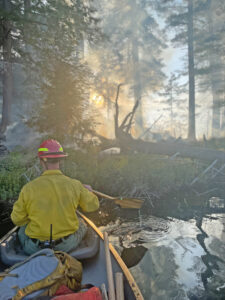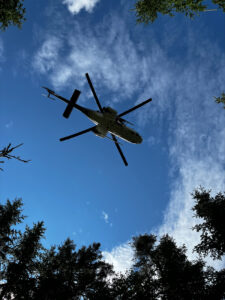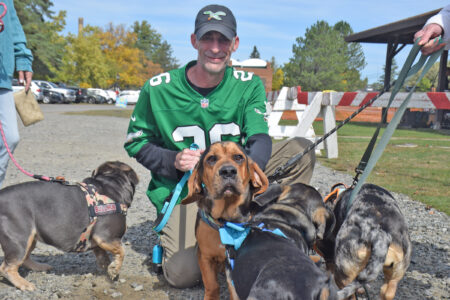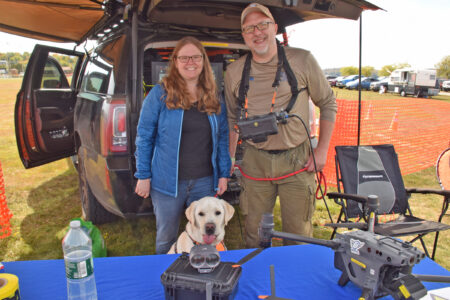Eyes in the sky
Drone pilot who found Porter details process

Allison and Rob Russell smile with Echo at the fifth annual ADK Bark in the Park in Tupper Lake on Sunday. Rob is the owner of 2A TAC Air OPS Drone Services, which successfully rescued Porter, a chocolate lab who ran off following a car crash near Donnelly’s Corners last week. (Enterprise photo — Chris Gaige)
TUPPER LAKE — Last week, friends, family and volunteers spent nearly 40 hours searching for Porter, a chocolate lab who escaped and ran off after a car crash near Donnelly’s Corners, about 5 miles north of Saranac Lake.
As the search went on, the decision was made to take it to the next level — literally. Rob Russell, who owns and operates 2A TAC Air OPS Drone Services, was called in to search for Porter using a heat-sensing drone. Less than an hour after the drone launched, Porter was found. He was subsequently given a clean bill of health and reunited with his owners. That story is available at tinyurl.com/27ve58py.
It was a quick and happy ending for Russell, who has built a career out of using technologically-advanced drones to help search for lost pets, livestock and, sometimes, even people. Russell is an FAA-licensed commercial drone pilot who’s based out of New Hampshire. He travels throughout the Northeast, often driving hundreds of miles to assist in these searches.
His truck is outfitted as a full-fledged mobile operations center. It houses computers, chargers, long-distance radio and various accessories needed for a search. Given his central role in Porter’s search, he was invited to the Tri-Lake Humane Society’s ADK Bark in the Park on Sunday, where he showcased his technologies and methodologies.
“I fly some of the best thermal drones they make,” he said. “These are all-weather drones. They can go up in high winds, downpours, blizzards — they’re made to go out in really bad weather.”
Russell has been doing this for about the last 3 years. He said he sort of fell into the business by accident. He first bought a cheaper and less sophisticated drone than what he uses now, thinking his drone business would center around more routine work like roof or solar panel inspections.
“I would’ve been bored out of my mind, I just didn’t know that at the time,” he said.
Then, a neighbor lost a dog, and he saw an opportunity to help. After a successful find, he put a message out on his town’s Facebook group letting people know that he’d come out for free then and help search for their missing pet.
The calls poured in, and Russell decided to make a career out of it. He now charges, based scope of the project, as it’s now his full-time livelihood and has made extensive investments in his technological setup. Every situation is unique, and Russell said when people call in, he first gathers as much information as possible about the incident. He’s upfront with the potential client about how useful his services will be, given the specifics.
“Ethics is a big deal,” he said. “There are times when I tell them, ‘I just don’t think a drone is really appropriate or I just don’t think the odds of it yielding a result are very high.”
If Russell is ultimately called in, the first step is finding a good launch zone, with higher ground tending to give him a better range. He starts his searches at the point where the animal was last seen, fanning out in a more-or-less overlapping grid search, though he said the pattern varies a bit depending on the animal.
“I’ve gotten a lot better as I’ve gone on with this,” he said. “Depending on the animal, I tailor (the search pattern) a lot to specific situations. … Certain animals are more apt to do things differently when they’re in a panic mode, which most of these animals are.”
Russell doesn’t just locate the animal from above. He also oversees the approach process when the animal is found, and has a variety of strategies to make sure it doesn’t run away again. The animal, even if it’s a pet, is often in a fight-or-flight mode after being lost for an extended duration.
An integral part of Russell’s operation are his long-range radios, which he also has a business license to operate. Russell said his radios are reliable across a 5 to 10-mile distance, which he uses to coordinate how rescuers approach the animal and close the perimeter.
“As I’m sending, say, the owner of a dog in, I’m keeping my eye on the animal (using the drone),” he said. “There’s a very specific way for even the owner to approach a dog.”
Russell employs the ‘calming signals approach,’ which was created by Turid Rugaas, a Norwegian dog trainer and ethologist, in real time, depending on what the dog is doing. Russell added that his drone is high enough off the ground that it doesn’t spook the animal.
He said even though he works out a plan with the owner in advance, when they see their dog on the drone screen or hear that it’s been found, the adrenaline can start rushing. That’s when it’s Russell’s job to keep the owner composed and make sure they are following the plan.
“If they yell their dog’s name, if they clap their hands, if they run after their dog — the dog’s going to run off,” he said. “And a lot of people just don’t know that.”
It’s only when the animal has been found and is no longer loose that Russell can catch his breath.
“I do like to remind people that I do a lot more than just flying the drone,” he said. “The drone is my search method, but once we find the animal, there’s a lot more that I do.”
More information about Russell’s work can be found at 2adrones.com.




